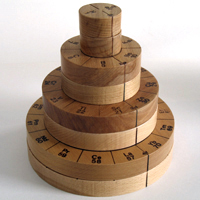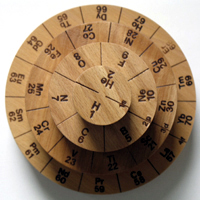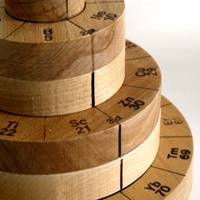


| PERIODIC ROUND TABLE |
| Introduction | | Papers | | Explanation | | Order | | About the Author |
 |
 |
 |
For a comprehensive understanding
of the concepts related to the Periodic Round Table, please click on the
titles of the papers below to download a .pdf copy. ABSTRACT : EIGHT
PERIOD TABLE for the 21st CENTURY (.pdf) The Periodic Table was developed in the nineteenth century and expanded
in the twentieth century. Now in the twenty first century we have the
perspective to see that the Periodic Table needs to be redrawn with eight
periods to make it consistent with the system of electronic configuration. This redesign has been continually proposed by various scientists since
1928 but has been largely overlooked because of difficulties placing elements
hydrogen and helium, elements one an two. Astrophysical evidence of nucleosynthesis
shows that hydrogen and helium are the progenitor elements, so there is
good reason to place them in a separate period above the rest of the elements,
ungrouped to elements below. ABSTRACT : THE
PERIODIC TABLE: LOOKING FORWARD IN 2008 (.pdf) The history of the Periodic Table was one of discovery of the many elements
and then piecing together the parts of the puzzle that would become the
Periodic Table. At the time of Mendeleev’s first Table in 1870,
only 60 elements were known,a number that increased through episodic bursts
of discovery until today virtually all the 118 spaces of the standard
display are full. The current display is not expandable above 118, nor does it present
the “f” elements in an integral manner with the rest of the
chart. These are reasons enough to undertake a transition to the electronic
configuration type table which is infinitely expandable and displays all
the elements according to a regular mathematical plan. ABSTRACT : POST
MENDELEEVIAN EVOLUTION OF THE PERIODIC TABLE (.pdf) This paper, presented in August 2007, commemorates the centennial of
Mendeleev’s death. How would he have viewed the redevelopment of
the Periodic Table in the last hundred years? Would he have agreed with
the standard format now in use, or would he advocate a format consistant
with the chart of electronic configuration? One thing is becoming apparent;
the standard format has no expandability beyond atomic number 118, yet
increasingly we are seeing theoretical and experimental results for elements
beyond that point. ABSTRACT: THE MANY
LOOKS OF THE PERIODIC TABLE (Written for high school students; can be found at acs.org/chemmatters) |